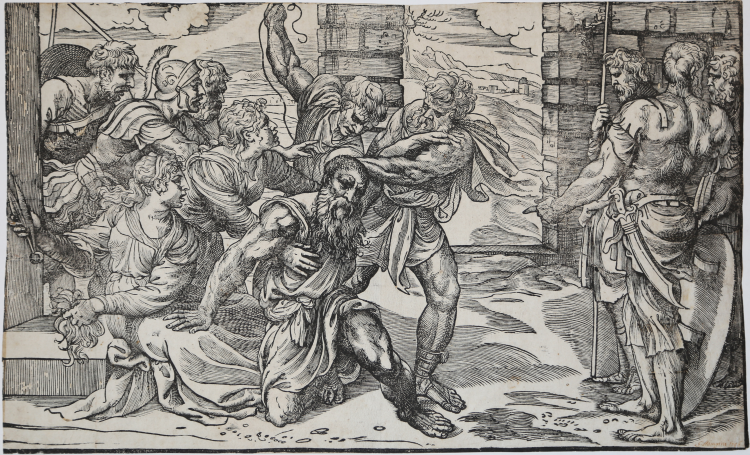



| Reference: | S42084 |
| Author | Niccolò BOLDRINI |
| Year: | 1540 ca. |
| Measures: | 490 x 302 mm |


| Reference: | S42084 |
| Author | Niccolò BOLDRINI |
| Year: | 1540 ca. |
| Measures: | 490 x 302 mm |
Woodcut, 1540 circa, unlettered.
After Titian’ drawing.
Samson with shaved head and long beard is bound with a rope by soldiers, as he supports himself on the thigh of Delilah, who holds a scissors and a handful of hair.
The main group is a reverse of a Raphaelesque engraving attributed to Giovanni Antonio da Brescia (see Hind 1938-48 vol. V, p. 44, no. 23). Titian redesigned the whole scene, recalling also other Raphaelesque inventions, such as the Massacre of the Innocents and the Battle of Ostia; but in this process of revival he succeeded in infusing a completely new life and energy; this is especially seen in the heroic figure of Samson, who, besides the vigor of his anatomy, makes use of a graphic technique and a complexity of signs that are completely new and of great effect: thus the new conception of the figures corresponds also to a diversity of expressive means.
A fine impression, printed on contemporary laid paper, trimmed to the borderline, some expert repairs at the back, otherwise very good condition. Ink signature at the lower right corner: G. Stampini 1796.
Bibliografia
Rosand and Muraro (1976), p. 113, n. 48; Passavant VI.223.5.
Niccolò BOLDRINI (Vicenza, 1500 circa; Venezia, 1530–70)
|
Italian wood-engraver. He is known only by his signed prints drawn from the designs of various artists. The inscription TITIANVS INV/Nicolaus Boldrinus/Vicenti[n]us inci/debat. 1566 on the chiaroscuro woodcut of Venus and Cupid testifies to its derivation from a Titian model as well as to its date. Boldrini was long considered the engraver of Titian’s work par excellence and his direct collaborator, but today critical opinion (Oberhuber) tends to see such collaboration only in the famous woodcut of the Six Saints. Stylistic and historical considerations lead to the conclusion that some landscape prints, such as Landscape with a Milkmaid and St Jerome in the Wilderness, are not the product of a direct relationship between Boldrini and Titian but rather the work of the German Giovanni Britto. Of around 30 works of very different style and engraving quality that have been assigned to Nicolò Boldrini, among the most famous, also known in chiaroscuro forms, are the Caricature of Laokoon and Marco Curzio by Pordenone.
|
Niccolò BOLDRINI (Vicenza, 1500 circa; Venezia, 1530–70)
|
Italian wood-engraver. He is known only by his signed prints drawn from the designs of various artists. The inscription TITIANVS INV/Nicolaus Boldrinus/Vicenti[n]us inci/debat. 1566 on the chiaroscuro woodcut of Venus and Cupid testifies to its derivation from a Titian model as well as to its date. Boldrini was long considered the engraver of Titian’s work par excellence and his direct collaborator, but today critical opinion (Oberhuber) tends to see such collaboration only in the famous woodcut of the Six Saints. Stylistic and historical considerations lead to the conclusion that some landscape prints, such as Landscape with a Milkmaid and St Jerome in the Wilderness, are not the product of a direct relationship between Boldrini and Titian but rather the work of the German Giovanni Britto. Of around 30 works of very different style and engraving quality that have been assigned to Nicolò Boldrini, among the most famous, also known in chiaroscuro forms, are the Caricature of Laokoon and Marco Curzio by Pordenone.
|